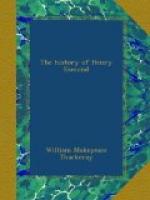Though the troopers of the King’s Life-Guards were all gentlemen, yet the rest of the gentlemen seemed ignorant and vulgar boors to Harry Esmond, with the exception of this good-natured Corporal Steele the Scholar, and Captain Westbury and Lieutenant Trant, who were always kind to the lad. They remained for some weeks or months encamped in Castlewood, and Harry learned from them, from time to time, how the lady at Hexton Castle was treated, and the particulars of her confinement there. ’Tis known that King William was disposed to deal very leniently with the gentry who remained faithful to the old King’s cause; and no prince usurping a crown, as his enemies said he did, (righteously taking it, as I think now,) ever caused less blood to be shed. As for women-conspirators, he kept spies on the least dangerous, and locked up the others. Lady Castlewood had the best rooms in Hexton Castle, and the gaoler’s garden to walk in; and though she repeatedly desired to be led out to execution, like Mary Queen of Scots, there never was any thought of taking her painted old head off, or any desire to do aught but keep her person in security.
And it appeared she found that some were friends in her misfortune, whom she had, in her prosperity, considered as her worst enemies. Colonel Francis Esmond, my lord’s cousin and her ladyship’s, who had married the Dean of Winchester’s daughter, and, since King James’s departure out of England, had lived not very far away from Hexton town, hearing of his kinswoman’s strait, and being friends with Colonel Brice, commanding for King William in Hexton, and with the Church dignitaries there, came to visit her ladyship in prison, offering to his uncle’s daughter any friendly services which lay in his power. And he brought his lady and little daughter to see the prisoner, to the latter of whom, a child of great beauty and many winning ways, the old Viscountess took not a little liking, although between her ladyship and the child’s mother there was little more love than formerly. There are some injuries which women never forgive one another; and Madam Francis Esmond, in marrying her cousin, had done one of those irretrievable wrongs to Lady Castlewood. But as she was now humiliated, and in misfortune, Madam Francis could allow a truce to her enmity, and could be kind for a while, at least, to her husband’s discarded mistress. So the little Beatrix, her daughter, was permitted often to go and visit the imprisoned Viscountess, who, in so far as the child and its father were concerned, got to abate in her anger towards that branch of the Castlewood family. And the letters of Colonel Esmond coming to light, as has been said, and his conduct being known to the King’s council, the Colonel was put in a better position with the existing government than he had ever before been; any suspicions regarding his loyalty were entirely done away; and so he was enabled to be of more service to his kinswoman than he could otherwise have been.




